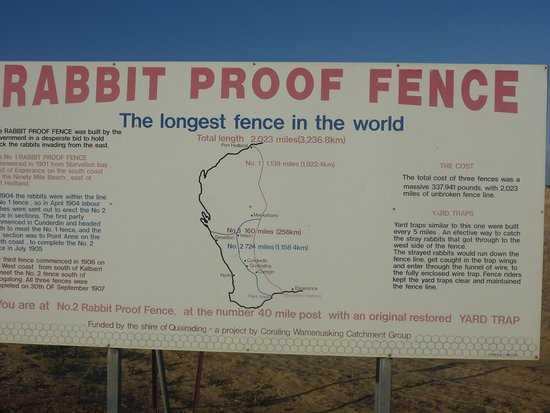
The movie “Rabbit-Proof Fence” is a powerful and thought-provoking film that tells the story of three young Aboriginal girls who escape from a government settlement and embark on a long and treacherous journey to find their way back home. This film raises many questions about colonialism, identity, and resilience. In this article, we will explore some of the most frequently asked questions about “Rabbit-Proof Fence” and provide insightful answers to deepen your understanding of this extraordinary story.
Q: What is the significance of the title “Rabbit-Proof Fence”?
A: The rabbit-proof fence referenced in the title is a real structure that was built in Western Australia during the late 19th century. It was designed to keep rabbits, an introduced species, away from agricultural land. In the context of the movie, the rabbit-proof fence symbolizes the oppressive and restrictive policies of the Australian government, as it parallels the fence that separates the indigenous population from the settler society.
Q: What does the film “Rabbit-Proof Fence” reveal about the impact of colonialism on Aboriginal communities?
A: “Rabbit-Proof Fence” sheds light on the devastating effects of colonialism on Aboriginal communities in Australia. The film demonstrates how the government forcibly removed indigenous children from their families and placed them in institutions, with the aim of assimilating them into white society. This practice, known as the Stolen Generations, had a profound and lasting impact on Aboriginal communities, resulting in the loss of culture, language, and identity.
Q: What themes does “Rabbit-Proof Fence” explore?
A: “Rabbit-Proof Fence” explores several important themes, including the resilience and strength of indigenous peoples, the impact of government policies on marginalized communities, and the importance of cultural preservation. The film also raises questions about identity and the search for belonging, as the three girls navigate the complexities of their mixed heritage.
Q: How does “Rabbit-Proof Fence” challenge traditional storytelling conventions?
A: “Rabbit-Proof Fence” deviates from traditional storytelling conventions by focusing on the experiences and perspectives of indigenous characters. The film highlights the resilience and determination of Molly, Daisy, and Gracie, allowing their voices and agency to drive the narrative. By centering the story on these Aboriginal girls, the film challenges the dominant narrative and provides a platform for marginalized voices to be heard.
By exploring these questions and providing meaningful answers, we hope to deepen your understanding and appreciation of the film “Rabbit-Proof Fence” and the important themes it addresses. This powerful story serves as a reminder of the resilience of Aboriginal communities in the face of oppression and the ongoing struggle for cultural preservation and recognition.
Rabbit Proof Fence Questions and Answers

In the film “Rabbit Proof Fence”, directed by Phillip Noyce, the story follows the journey of three Aboriginal girls who escape from a government settlement and embark on a long and dangerous journey home. Here are some questions and answers about the film:
1. What is the significance of the rabbit-proof fence in the film?
The rabbit-proof fence is a physical barrier that stretches across Western Australia and serves as a metaphor for the oppression and control of the Aboriginal people. It represents the government’s attempts to assimilate and control the Indigenous population by separating them from their families and cultures.
2. Who are the main characters in the film?
The main characters in the film are three Aboriginal girls named Molly, Daisy, and Gracie. They are part of the Stolen Generations, a group of Indigenous children who were forcibly removed from their families and placed in government settlements.
3. What challenges do the girls face on their journey home?
The girls face numerous challenges on their journey home, including harsh weather conditions, limited food and water supplies, and the constant threat of being apprehended by authorities. They also have to navigate unfamiliar landscapes and avoid dangerous animals.
4. Why is the journey home important to the girls?
The journey home is important to the girls because it represents their freedom and their desire to be reunited with their families and communities. It is a symbol of resistance against the oppressive policies of the government and a way for them to reclaim their identity and culture.
5. What is the message of the film?

The film’s message is about the strength and resilience of the human spirit, particularly in the face of adversity and injustice. It highlights the importance of cultural identity and the fight for freedom and equality. It also serves as a reminder of the ongoing struggles faced by Indigenous peoples and the need for reconciliation and understanding.
In conclusion, “Rabbit Proof Fence” is a powerful film that sheds light on the dark chapters of Australian history and the impact of government policies on Indigenous communities. It raises important questions about identity, cultural heritage, and the resilience of the human spirit.
What is the Rabbit Proof Fence?
The Rabbit Proof Fence is a physical barrier that was built in Western Australia to control the population of rabbits. It was constructed between 1901 and 1907 and stretches over 1,833 kilometers. The fence was originally designed to prevent the spread of rabbits from the east coast to the farmlands in the west.
The Rabbit Proof Fence consists of a series of fences, including the No. 1 Fence, also known as the State Barrier Fence, which stretches from north to south. It is made up of wire and posts, with mesh at the bottom to prevent rabbits from digging under. The fence is approximately 1.2 meters tall and was designed to be rabbit-proof, hence its name.
The Rabbit Proof Fence was built to protect agricultural lands from the destruction caused by rabbits, which had been introduced to Australia in the 19th century and quickly multiplied, becoming a major pest. Rabbits pose a threat to the environment and agriculture as they eat vegetation, compete with native animals for food and habitat, and cause soil erosion.
The construction of the Rabbit Proof Fence was a massive undertaking and required extensive planning and labor. It involved clearing the land, digging trenches, and erecting the fences. Despite its initial purpose, the fence also became a symbol of segregation and separation, particularly for the Indigenous people who were displaced and restricted from their traditional lands by the fence.
Today, the Rabbit Proof Fence still exists, although parts of it have been removed or modified. It serves as a reminder of Australia’s history and the impact of introduced species on the environment, as well as the complex relationship between humans and the land.
Why was the Rabbit Proof Fence built?
The Rabbit Proof Fence was built in Australia with the purpose of controlling and containing the population of rabbits that were causing significant damage to the country’s agricultural lands. Introduced by European settlers in the 19th century, rabbits quickly multiplied and became a pest, ravaging crops, destroying pastures, and damaging fences. Recognizing the urgent need to tackle this problem, the government took action to construct a barrier that would prevent rabbits from spreading further and limit their impact on agriculture.
The construction of the Rabbit Proof Fence was a massive undertaking, spanning over 3,253 kilometers and comprising of three separate fences: No. 1 Fence, No. 2 Fence, and No. 3 Fence. The initial construction began in 1901 and continued for several years, with the aim of creating an impenetrable barrier to keep rabbits out of the agricultural areas in Western Australia.
The Rabbit Proof Fence played a crucial role in protecting farmlands and preserving the livelihoods of many farmers. It effectively prevented rabbits from infiltrating and damaging crops, allowing for better agricultural productivity and reducing economic losses. The fence also helped to prevent the spread of diseases carried by rabbits, protecting both human health and the health of livestock.
Overall, the Rabbit Proof Fence was built to address the significant environmental and economic issues caused by the overpopulation of rabbits in Australia. Its construction was a proactive measure that aimed to protect the country’s agricultural assets and ensure the sustainability of the farming industry.
Who built the Rabbit Proof Fence?
The Rabbit Proof Fence, also known as the State Barrier Fence, was a massive construction project built in Western Australia during the early 1900s. It was designed to keep rabbits and other pests out of agricultural areas and prevent them from spreading across the state. The fence was built by a team of workers under the supervision of the Western Australian government’s Department of Agriculture.
The construction of the Rabbit Proof Fence started in 1901 and took several years to complete. It stretched over 3,256 kilometers from the cliffs of the southern coast near Esperance to the cliffs of the northern coast near Port Hedland. The fence was made up of multiple strands of wire mesh, supported by wooden posts and concrete pillars.
Key figures involved in the construction:
- Captain Gunther Saggers: He was appointed as the first Chief Inspector of the Rabbit Proof Fence. Saggers was responsible for overseeing the construction and maintenance of the fence.
- Mick Magee: He was the chief surveyor for the Rabbit Proof Fence project. Magee played a crucial role in mapping out the route and determining the exact location of the fence.
- John Holland: He was the contractor hired by the government to carry out the construction work. Holland and his team of workers faced numerous challenges, including harsh weather conditions and the remote and demanding terrain.
- Indigenous labor force: Aboriginal people, particularly from the Martu, Ngalia, and Wangkatja tribes, played an essential role in building and maintaining the Rabbit Proof Fence. They were employed as laborers and worked alongside European settlers.
The construction of the Rabbit Proof Fence was a massive undertaking and a testament to human ingenuity and perseverance. Although it did not completely eradicate the rabbit population, it significantly reduced their numbers and protected valuable agricultural land in Western Australia.
How long is the Rabbit Proof Fence?
The Rabbit Proof Fence is a historical fence that was built in Western Australia between 1901 and 1907. It stretches for a total length of approximately 3,253 kilometers, making it one of the longest fences in the world.
The purpose of the Rabbit Proof Fence was to keep rabbits and other pests out of the fertile agricultural areas of Western Australia. The fence was designed to be rabbit-proof by using a combination of wire netting and special gates that were designed to be difficult for rabbits to climb or burrow under. The fence also served as a boundary, separating the agricultural areas from the vast Australian outback.
The construction of the Rabbit Proof Fence was a massive undertaking. It required the labor of thousands of workers and involved the use of over 200,000 tons of galvanized steel wire. Despite its length, the fence was completed in just a few years, thanks to the dedication and hard work of the construction teams. Today, the Rabbit Proof Fence remains an important historical site and a symbol of the challenges faced by early settlers in Australia.
- The Rabbit Proof Fence is approximately 3,253 kilometers long, making it one of the longest fences in the world.
- It was built between 1901 and 1907 to keep rabbits and other pests out of the fertile agricultural areas of Western Australia.
- The fence used a combination of wire netting and special gates to make it rabbit-proof.
- It required the labor of thousands of workers and over 200,000 tons of galvanized steel wire to construct.
Where is the Rabbit Proof Fence located?
The Rabbit Proof Fence is located in Western Australia, stretching across the state from north to south. It was built in the early 1900s as a measure to control the population of rabbits, which were causing significant damage to agricultural land and ecosystems in the region. The fence covers a total distance of approximately 3,256 kilometers, making it one of the longest fences in the world.
The Rabbit Proof Fence starts near the town of Narembeen in the south and runs all the way up to the town of Port Hedland in the north. It is divided into three main sections: the No. 1 Fence, which begins at Narembeen and ends at Meekatharra, the No. 2 Fence, which runs from Meekatharra to Cue, and the No. 3 Fence, which extends from Cue to Port Hedland. These sections were strategically placed to create a barrier for rabbits, preventing them from spreading further into agricultural areas.
The construction of the Rabbit Proof Fence was a challenging task, with workers facing the harsh conditions of the Australian outback. The fence consists of a series of wire-mesh nets that are stretched between wooden posts, providing a physical barrier for rabbits. Over the years, the fence has been repaired and maintained to ensure its effectiveness in controlling the rabbit population. Today, the Rabbit Proof Fence stands as a symbol of Australia’s efforts to protect its agricultural resources and preserve its unique ecosystems.
What is the significance of the Rabbit Proof Fence in Australian history?

The Rabbit Proof Fence holds great significance in Australian history as it represents the injustices endured by Indigenous Australians during the era of British colonization. The fence was constructed in the early 1900s as a means to control the population of rabbits, which had proliferated and was causing significant damage to agricultural land. However, the construction of the fence also had a devastating impact on the Aboriginal people, as it restricted their movement and disrupted their traditional way of life.
Symbol of cultural resilience
The Rabbit Proof Fence became a symbol of cultural resilience for the Indigenous Australians, particularly for the Stolen Generations. The fence served as a physical barrier that divided families and separated children from their parents. The film “Rabbit-Proof Fence” captures the story of three young girls who escape from a government-run settlement and embark on an arduous journey back home, following the fence as their guide. Their defiance and determination to find their way back to their families represent the endurance and strength of the Aboriginal people in the face of adversity.
Legacy of colonization
Furthermore, the Rabbit Proof Fence also highlights the lasting legacy of colonization in Australia. The construction of the fence was an extension of the British government’s policy of assimilation and forced removal of Indigenous children from their families. The film and the fence itself serve as a reminder of the ongoing struggle for recognition, justice, and reconciliation for the Aboriginal people.
Monument to resilience and resistance
Today, the Rabbit Proof Fence stands as a monument to the resilience and resistance of Indigenous Australians. It serves as a reminder of the atrocities committed against them and the ongoing need for reconciliation and addressing historical injustices. The fence has also become a significant tourist attraction, attracting visitors who seek to learn about Indigenous history and gain a deeper understanding of the impact colonization has had on Australia’s First Nations people.